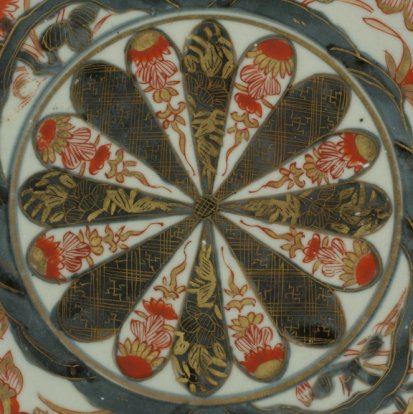Sold Ceramics

Sold Ceramics - Sold Japanese Imari 1690-1800 - Dishes - Page 1
Object 2011889
Dish
Japan
1700-1720
Height 41 mm (1.61 inch), diameter of rim 245 mm (9.65 inch), diameter of footring 132 mm (5.02 inch), weight 582 grams (20.53 ounce (oz.))
Dish on footring, straight rim and slightly upturned edge. On the base four spur-marks in a Y-pattern. Imari, decorated in underglaze blue, iron-red and gold with a stylized 16-petal chrysanthemum crest, (kiku no mon). The petals are decorated in gold and iron-red and gold reserved on an underglaze blue ground. Those in gold reserved on an underglaze blue ground show either a lozenge diaper pattern (tasuki) or floral scrolls. Those in red and gold show designs of a flowering chrysanthemum. On the sides two groups of flowering plants, chrysanthemum alternating with peony both growing from rockwork. On the rim flowerheads between scrolls in gold on an underglaze blue ground. The reverse with chrysanthemum, peony and prunus sprays.
Although some types of chrysanthemum begin flowering in the summer, the chrysanthemum is primarily an indication of autumn. Like many autumn motifs the chrysanthemum evokes feelings of melancholy in Japan, as is beautifully expressed in a poem by the 9th-century Ki no Tomonori:
tsuyu nagara / to wear in my hair
arite kazasamu / I plucked a chrysanthemum
kiku no hana / with dew still clinging to it
aisenu aki no / oh may this present
hisashikarubeku / autumn's youth last forever
Despite the chrysanthemum's status as a symbol of the Japanese imperial house, this meaning is only relevant when a 'sixteen'-fold double chrysanthemum', the stylized family crest (mon), is placed prominently and singly on an object.
(source: Fitski 2011, p.149)
For an identically decorated dish, please see:
- Mistrovská dĩla Japonského porcelánu / Masterpieces of Japanese Porcelain, (F. Suchomel, Prague 1997), p.145, cat. 197.
- Imari-Porzellan am Hofe der Kaiserin Maria Theresia, exhibition catalogue (Hetjens-Museum, Düsseldorf, 2000), p.83, cat. 58.
For dishes with a similarly large central chrysanthemum crest, (kiku no mon), please see:
- Porzellan aus China und Japan. Die Porzellangalerie der Landgrafen von Hessen-Kassel, Staatliche Kunstsammlungen Kassel, Berlin 1990, p.518, cat. 286.
- Ko-Imari from the collection of Oliver Impey, (Barry Davies Oriental Art, London, 1997), pp. 200-201, cat. 119.
- Mistrovská dĩla Japonského porcelánu / Masterpieces of Japanese Porcelain, (F. Suchomel, Prague 1997), p.109, cat. 104 & p.128, cat 156.
- Japanese Export Porcelain. Catalogue of the Collection of the Ashmolean Museum, Oxford, (O. Impey, Hotei Publishing, Amsterdam, 2002), p.210, cat. 354.
- Fine & Curious: Japanese Export Porcelain in Dutch Collections, (C.J.A. Jörg, Hotei publishing, Amsterdam, 2003), p.117, cat.126 & p.197, cat. 247 & 247a.
- Complete Catalogue of the Shibata Collection, (The Kyushu Ceramic Museum, Kyushu 2003), p.356, cat. 2789.
For a dish with a similarly large central chrysanthemum crest, (kiku no mon), formerly part of the Dresden collection formed by Friedrich August or August the Strong, Elector of Saxony and King of Poland please see:
Condition: A hairline and a popped bubble of glaze (caused during the firing process) to the rim.
References:
Suchomel 1997, cat. 104, 156 & 197
Jörg 2003/1, cat. 126, 247 & 247a
Price: Sold.
More pictures of object 2012615, another identically shaped and decorated, sold, dish >>



 create websites
create websites